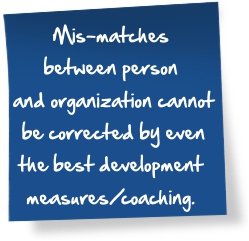
What is your company’s key organizational and human development processes to support the achievement of corporate goals and strategy to make a measurable contribution to your company?
In order to leverage sustainable strategic value contribution different systems and programs are needed. The challenge is not to have single measures and a collection of workshops in the training catalogue, but to design a comprehensive approach to align corporate strategy, corporate culture and core competencies in all personnel and staff development programs (integrated development measures that are embedded in the organizational development). As it also needs to coordinate roles and responsibilities between line managers and Human Resources managers.
Benefits (among others):
Targeted, profitable and value-adding HR-/Talent Management processes and measures, increased contribution to ensure company’s goals, more involvement in relevant management decisions, built up and usage of business relevant metrics and KPI´s, strengthened positioning of HR (enhanced acceptance and perception of HR not as a cost driver, but as a value-adding partner)
Target group:
Management, HR Management (organizational and personnel development)
Possible topics/goals:
1. Strategic workforce planning & placement: What internal and external trends are relevant for internal succession planning, training of individuals and teams and external placements? What needs to be considered for an effective succession planning? What is relevant for sourcing, based on the findings of internal and external trends, defined key roles and core competencies?
2. Recruiting: How is the recruitment process designed and how does it link to other key HR pro-cesses & standards? Who conducts the recruitment interviews and how? How does the compe-tence & potential assessment perform (organization & job fit)? Which benchmarks and quality standards are qualified to enhance the company specific recruitment process (response times, occupation times, miscast rate, …)
3. Remuneration and incentive systems: To what extent does the remuneration and incentive system support the strategic imperatives of the business? How is the process of compensation organized and aligned? How is the performance evaluation linked to bonuses? How is the communication? Are all promising options exploited?
4. Hiring, on-boarding & exits: What is an effective on-boarding? What elements of a 100 day plan are (company specific) central in ensuring that people new in role can perform faster and more effectively? How is the termination process? How are transfer processes organized?
5. Personal development: What cost-effective and targeted methods (including side-by-sides, feedback, appraisals, delegation, job rotation/enlargement/enrichment) are used for staff development? What is used internally (on the job), what external (off the job)? What tools are made available on the intranet? How effective is HR development & training controlling (ROE = Return on Education) and targeted development planning?
6. Evaluation (performance & potential): Are there updated, clear functional descriptions that make the profit responsibility of individual roles clear? Is there a transparency about expectations/goals to the role owner? Are ambitions-level, i.e. performance, service, quality criteria discussed as a basis for performance feedback reviews? Are annual Talent Management Reviews systematically implemented and cascaded?
7. Career planning: How are employee development discussions designed (including the role of (top) management, works council involvement)? How are potential assessments and learning curve analysis conducted? How are development measures designed? How relevant are manager supported learning projects (on the job, enlarged assignments and strategic projects) in relation to self- steered (e-learning, on the job) and external qualification (training, coaching)?
8. Employee surveys: What? How? When? Objectives, content/questions, expiration; preparation of leaders how to conduct evaluation reviews with their teams/use of results; implementation concept, action plan
9. Talent & leadership programs: Introduction (success factors/critical factors), goal setting, selection of participants, involvement of managers, content, duration, scope, sequence, conclusion and follow-up actions
10. Leadership development: Leadership branding (what can employees expect the leaders of your company? Values and leadership practices), leadership communication and cascaded goal setting
11. Certification in assessment/recruitment: How to qualify recruiters effectively? What are the focus topics to evaluate personnel selection? How to run a certification (e.g. role of leaders, …)?

